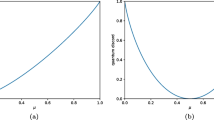Abstract
The double wave theory (DWT), sometimes called the “non-statistical quantum mechanics” by its proposer, describes the state of each single particle in an ensemble with two wave functions which have a parameter corresponding to the particle. However the basic postulates of the DWT show that this theory can hardly describe any quantum rules of the microscopic world. In the double wave descriptions, the wave feature of the behavior of microscopic particles and the discontinuity characteristic of energy almost disappear. The discussions on several problems of the radiation atoms made by the DWT’s proposer on the basis of this theory are either mathematically incorrect or inconsistent with experiments and the usual theory.
Similar content being viewed by others
References
Huang Xiangyou, New suggestion to describe the radiation atoms, Scientia Sinica, Ser. A, 1988, 31(9): 1141.
Huang Xiangyou, New Ponderation on Quantum Mechanics, Chengdu: Sichuan Science & Technology Press, 1989.
Huang Xiangyou, A proposed new description of linear oscillators, Chin. Phys. Lett., 1987, 4(4): 153.
Huang Xiangyou, New suggestions for free particles, Phys. Lett. A, 1986, 115(7): 310.
Huang Xiangyou, Qian Shangwu, Liu Quanhui et al., Double wave description of single particle in an infinitely deep square potential well, Chin. Phys. Lett., 1990, 7(4): 152.
Huang Xiangyou, Liu Quanhui, Tian Xu et al., Double wave description of the motion of a charged particle in a uniform magnetic field, Acte Physica Sinica, 1993, 42(2): 180.
Huang Xiangyou, Zhang Bin, Double-wave answer to Schrödinger cat paradox, Acta Sinica Quantum Optica, 1996, 2(3): 130.
Huang Xiangyou, Double-wave calculation of the time of penetration of potential barrier, Chinese Science Bulletin, 1996, 41 (20): 1843.
Lin Kunzhi, The description of double wave function of particle motion in the reflectionless potential well, Acta Physica Sinica, 1996, 45(3): 360.
Huang Xiangyou, Double wave description of the motion for a charged particle in mass spectrometer, Acta Physica Sinica, 1996, 45(5): 729.
Chen Changyuan, Liu Youwen, The exact solution of enharmonic oscillator potential and the description of double-wave function, Acta Physica Sinica, 1998, 47(4): 536.
Huang Xiangyou, Peng Jinsheng, New treatment of quantum revivals, Chin. Phys. Lett., 1989, 6(8): 351.
Zhang Li, Headway of Modem Physics, Beijing: Tsinghua University Press, 1997.
Author information
Authors and Affiliations
Corresponding author
Rights and permissions
About this article
Cite this article
Liang, F. A discussion on the double wave theory and its applications to description of radiation atoms. Sci. China Ser. A-Math. 44, 402–408 (2001). https://doi.org/10.1007/BF02878722
Received:
Issue Date:
DOI: https://doi.org/10.1007/BF02878722




